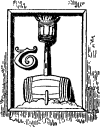Rebus
Rebus

Rebus: defined by Dr.Johnson as "a word represented by a picture." It is not a true heraldic term, and ought not to be applied to canting arms, but rather to those devices which are frequently found carved on buildings or painted in glass in reference to the name of the founders or benefactors. Such, for instance, are the following. Upon the Rector's lodgings at Lincoln College, Oxford, as well as on buildings at Wells, the rebus of a beacon and a tun is found in allusion to Thomas BECKYNTON, Bishop of Bath and Wells, 1443-65: and on a gateway at Canterbury, erected in 1517, a flint stone(supposed to be or) ensigned with a mitre is carved in allusion to Thomas GOLDSTONE, the second Prior Christ Church: while on a boss in the north transept of the Cathedral an eagle(for John) an ox and 'ne' stand for John OXNEY.
In a window in the lady-chapel in Gloucester Cathedral a comb and a tun appear in allusion to Thomas COMPTON, Abbot of Cirencester, 1480; and in one of the windows in the chapel at Lullingston, Kent, the arms of Sir John PEECHE are encircled by the branches of a peach-tree bearing peaches, each one of which has the letter e on it.
Again in books, Richard GRAFTON, the printer, in 1547, puts as his rebus on the last page, a tree or graft rising from a tun; and a copy of the "De Antiquitate Britannicæ Ecclesiæ," presented to Queen Elizabeth by the author, Matthew PARKER, Archbishop of Canterbury, has on the outside a park encloseed with pales embroidered on the green velvet binding.
Lastly, on seals a rebus very often appears, e.g. on that of Thomas WOODSTOCK, sixth son of Edward III., whose arms are engraved suspended from the stock of a tree.
Please Help!
DrawShield is a Free service supported by its users.

If you can, please help cover the cost of the server, or just buy the team a coffee to say thanks!
 Buy me a coffee
Buy me a coffee


